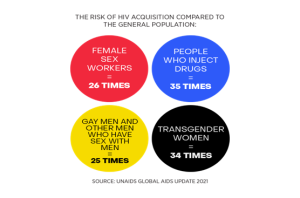key populations
Key populations are groups who, due to specific higher-risk behaviors, are at increased risk of HIV, irrespective of the epidemic type or local context. Also, they often have legal and social issues related to their behaviors that increase their vulnerability to HIV. Key Populations (KP) include sex workers, gay men and other men who have sex with men, transgender people, people who inject drugs, and people in prisons and other enclosed settings.
Too often, people most affected by HIV, tuberculosis and malaria are the same people who don’t have access to health care. Factors such as stigma, discrimination and criminalization are among the barriers that prevent them from accessing health services. LGBT rights awareness in Kenya.
LGBTQ rights awareness in Kenya
There is a lack of LGBT rights awareness in Kenya and also the law is against homosexuality. LGBTQ youths in Tharaka Nithi County are highly exposed to verbal and physical violence in homophobic social environments and they face socio psychological suffering such as a high risk of committing suicide, depression and anger accompanied by low self-esteem. There is no a multi-dimensional support system for LGBTQ youth to provide crisis intervention, help them recover from psychological pain and trauma, help enhance self-esteem and restore relationships with their parents or peers. LGBTQ youth cannot reveal themselves because of malicious publicity where public says that homosexuality is harmful and can have a bad influence on teenagers. In Kenya Student Rights Ordinance, prohibiting discrimination based on one’s sexual orientation and gender identity. Moreover, the LGBTQ youths right to receive education is denied. – LGBTQ youth drop out of school or run away.


The Bridging the Gaps programme
The Bridging the Gaps programme The Bridging the Gaps programme addresses the human rights violations and challenges faced by sex workers, people who use drugs, and lesbian, gay, bisexual, and transgender (LGBT) people, in accessing HIV and other essential health services. The Bridging the Gaps programme works with more than 20 local partner organisations. Key populations experience both increased impact from one or more of the diseases and decreased access to services. Widespread stigma and discrimination, state and non-state violence and harassment, restrictive laws and policies, and criminalization of behaviors or practices put key populations at heightened risks and undermine their access to services.
HIV
In the context of HIV, key populations include:
- Men who have sex with men
- Transgender people, especially transgender women
- Sex workers
- People who inject drugs
- People living with HIV
- People in prison and detention
These populations are socially marginalized, often criminalized and face a range of human rights abuses that increase their vulnerability to HIV.

TB
Prisoners and incarcerated populations, people living with HIV, migrants, refugees and indigenous populations are all groups that are highly vulnerable to TB, as well as experiencing significant marginalization, decreased access to quality services, and human rights violations. Miners in Southern Africa, for example, are reported to have greater incidence of TB than any other working population in the world, and TB incidence among migrant miners there is 10 times higher than in the communities from which they originate. The level of TB in prisons has been reported to be up to 100 times higher than that of the general population, according to the World Health Organization, and cases of TB in prisons may account for up to 25% of a country’s TB burden.
Among other populations, people living with HIV are 19 times more likely to develop active TB disease than people without HIV, according to the World Health Organization. At least 1 million children become ill with TB each year, representing about 10% of all TB cases, according to the organization.
Malaria
The concept of “key populations” in the context of malaria is relatively new and not yet as well defined as for HIV and TB. However, there are groups that meet the criteria for key populations. Refugees, migrants, internally displaced people and indigenous populations in malaria-endemic areas are often at greater risk of transmission, usually have decreased access to care and services, and are also often marginalized. The Africa Grassroots Empowerment Foundation (AGEF) also recognizes vulnerable populations – those who have increased vulnerabilities in a particular context, but may not fit the criteria highlighted above. These include adolescent girls and young women, and people with disabilities, among others.